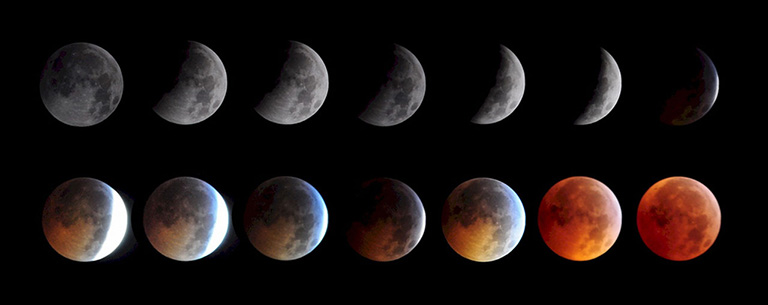The Super-Harvest-Blood Moon of 2015

This montage of images taken by skywatcher Kieth Burns shows the Dec. 20, 2010 total lunar eclipse. The photos won a NASA contest to become an official NASA/JPL wallpaper for the public. Credit: NASA/JPL-via Kieth Burns
This weekend we’re all in for a treat. The fall Harvest Moon, appearing on Sunday night, will also be a Super Moon and a Blood Moon. Here is some info and trivia tips to help you be the astronomer at the office and at home.
What is a Harvest Moon? In traditional sky lore, the Harvest Moon is the full moon closest to the autumnal equinox. For us in the Northern Hemisphere, the 2015 autumnal equinox comes on September 23, so the September 28 full moon counts as the Northern Hemisphere’s Harvest Moon. This year’s Harvest Moon will present the closest and largest full moon of the year and stage a total eclipse of the moon on the night of September 27-28. No matter where you are on Earth, a brilliant full-looking moon ascends over your eastern horizon around the time of sunset on September 27. It climbs highest in the sky around the middle of the night, when the sun is below your feet. That’s because the moon lies opposite the sun in our sky at the vicinity of full moon showing us its fully lighted hemisphere, or “day” side. That’s what makes the moon look full.
What makes this moon a Supermoon? This year’s Harvest Moon qualifies as a supermoon because the moon turns full about one hour after reaching lunar perigee – the moon’s closest point to Earth for the month. If you live on a coastline, watch for this full moon to bring along wide-ranging spring tides along ocean coastlines for several days following full moon – high tides will climb extra high and the low tides will fall exceptionally low.
What makes this moon a Blood Moon eclipse? This September full moon is also called a Blood Moon, because it presents the fourth and final eclipse of a lunar tetrad: four straight total eclipses of the moon, spaced at six lunar months (full moons) apart. The total lunar eclipse is visible from the most of North America and all of South America after sunset September 27. Here is the schedule using Eastern Daylight Time.
- Partial umbral eclipse begins: 9:07 p.m. EDT on Sept. 27
- Total eclipse begins: 10:11 p.m. EDT
- Greatest eclipse: 10:47 p.m. EDT
- Total eclipse ends: 11:23 p.m. EDT
- Partial eclipse ends: 12:27 a.m. EDT on September 28
What does this “trifecta” moon event mean for us? Although there is great folklore about the effects of a full moon, you have little to worry about. Scientists have studied human behavior and found little correlation between a full moon and people acting crazy. Here at KHT, we have all kinds of experience with crazy, so we plan on enjoying it with our families and friends!


